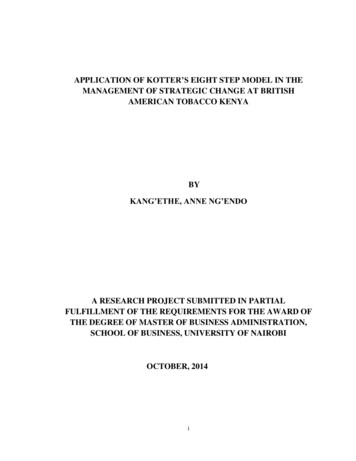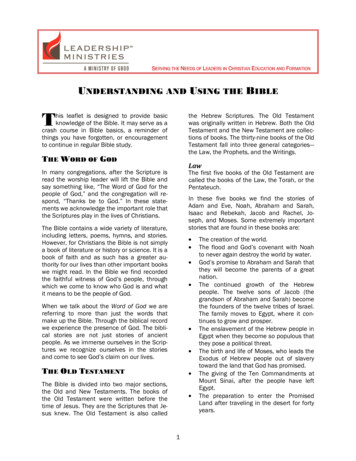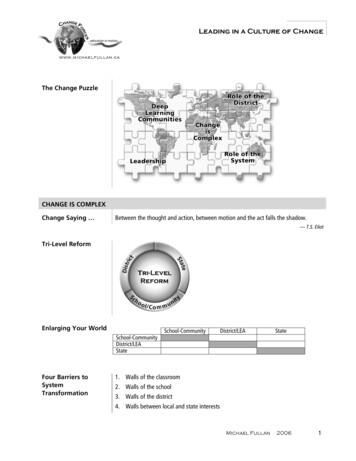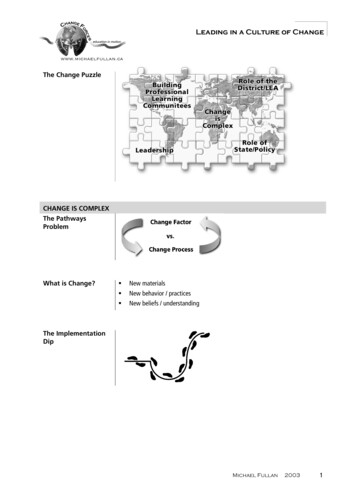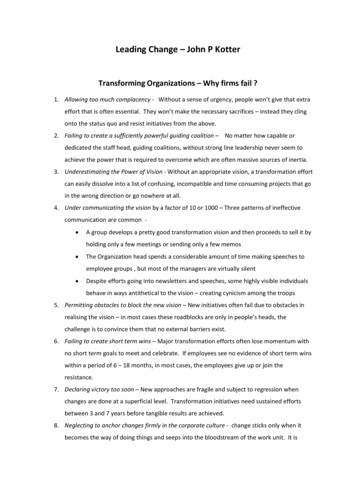
Transcription
Leading Change – John P KotterTransforming Organizations – Why firms fail ?1. Allowing too much complacency - Without a sense of urgency, people won’t give that extraeffort that is often essential. They won’t make the necessary sacrifices – instead they clingonto the status quo and resist initiatives from the above.2. Failing to create a sufficiently powerful guiding coalition – No matter how capable ordedicated the staff head, guiding coalitions, without strong line leadership never seem toachieve the power that is required to overcome which are often massive sources of inertia.3. Underestimating the Power of Vision - Without an appropriate vision, a transformation effortcan easily dissolve into a list of confusing, incompatible and time consuming projects that goin the wrong direction or go nowhere at all.4. Under communicating the vision by a factor of 10 or 1000 – Three patterns of ineffectivecommunication are common A group develops a pretty good transformation vision and then proceeds to sell it byholding only a few meetings or sending only a few memos The Organization head spends a considerable amount of time making speeches toemployee groups , but most of the managers are virtually silent Despite efforts going into newsletters and speeches, some highly visible individualsbehave in ways antithetical to the vision – creating cynicism among the troops5. Permitting obstacles to block the new vision – New initiatives often fail due to obstacles inrealising the vision – in most cases these roadblocks are only in people’s heads, thechallenge is to convince them that no external barriers exist.6. Failing to create short term wins – Major transformation efforts often lose momentum withno short term goals to meet and celebrate. If employees see no evidence of short term winswithin a period of 6 – 18 months, in most cases, the employees give up or join theresistance.7. Declaring victory too soon – New approaches are fragile and subject to regression whenchanges are done at a superficial level. Transformation initiatives need sustained effortsbetween 3 and 7 years before tangible results are achieved.8. Neglecting to anchor changes firmly in the corporate culture - change sticks only when itbecomes the way of doing things and seeps into the bloodstream of the work unit. It is
important that people are made aware that specific behaviours and attitudes have helpedimprove performance. The new policies should also reflect the changes made.The Eight Stage change process1. Establish a sense of urgencya. Examining the market and competitive realitiesb. Identifying and discussing crises, potential crises or major opportunities2. Creating the guiding coalitiona. Putting together a group with enough power to lead the changeb. Getting the group to work together like a team3. Developing a vision and strategya. Creating a vision to help direct the change effortb. Developing strategies for achieving that vision4. Communicating the change visiona. Using every vehicle possible to constantly communicate the new vision andstrategiesb. Having the guiding coalition role model the behaviour expected of the employee5. Empowering broad based actiona. Getting rid of obstaclesb. Changing systems or structures that undermine the change visionc. Encouraging risk taking or non-traditional ideas, activities and acitons6. Generating short term winsa. Planning for visible improvements in performance or “wins”b. Creating those winsc. Visibly recognizing and rewarding people who made the wins possible7. Consolidating gains and producing more changea. Using credibility to change all systems, structures, policies that don’t fit together anddon’t fit the transformation visionb. Hiring promoting and developing people who can implement the change visionc. Reinvigorating the process with new projects, themes and change agents8. Anchoring new approaches in the culturea. Creating better performance through customer and productivity oriented behaviour,more and better leadership and more effective management
b. Articulating the connections between the new behaviours and organizationalsuccessc. Developing means to ensure leadership development and successionThe first four steps in the transformation process help defrost a hardened status quo. Phases 5 – 7introduces new practices and the last stage grounds the change in the corporate culture and makethem stick.Establish a sense of urgencyWays to raise the urgency level1. Create a crisis by allowing a financial loss, exposing managers to major weaknesses vis-a-viscompetitors or allowing errors to blow up instead of being corrected at the last minute2. Eliminate obvious examples of excess (company owned country club facilities, gourmetexecutive dining rooms)3. Set revenue , income, productivity, customer satisfaction, and cycle time targets so high thatthey cannot be reached by conducting business as usual4. Stop measuring sub unit performance based only on narrow functional goals. Insist thatmore people be held accountable for broader measures of business performance5. Send more data about customer satisfaction and financial performance to more employeesespecially information that demonstrates weaknesses vis-a-vis competition.6. Insist that people talk regularly to unsatisfied customers, unhappy suppliers and disgruntledshareholders7. Use consultants and other means to force more relevant data and honest discussion intomanagement meetings8. Put more honest discussions of the firm’s problems in company newspapers and seniormanagement speeches. Stop senior management happy talk.9. Bombard people with information on future opportunities on the wonderful rewards forcapitalising on those opportunities and on the organization’s current inability to pursuethose opportunities.Creating guiding coalitionBuild a coalition that can make change happen
1. Find the right peoplea. With strong position, power, broad expertise and high credibilityb. With leadership and management skills, especially of the former2. Create trusta. Through carefully planned offsite eventsb. With lots of talk and joint activities3. Develop a common goala. Sensible to the headb. Appealing to the heartDeveloping a vision and strategyCharacteristics of an effective vision1. Imaginable – conveys a picture of what the future looks like2. Desirable – appeals to the long term interests of employees, customers, stock holders andothers who have a stake in the enterprise3. Feasible – comprises realistic attainable goals4. Focused – is clear enough to provide guidance in decision making5. Flexible - is general enough to allow individual initiative and alternative responses to light orchanging conditions6. Communicable – is easy to communicate, can be successfully explained within 5 minutesCommunicating the change visionKey elements in the effective communication of the vision1. Simplicity – all jargon and “techno babble” must be eliminated2. Metaphor, analogy, example – a verbal picture is worth a thousand words3. Multiple forums – big meetings and small, memos and newspapers, formal and informalinteractions – all effective for spreading the word4. Repetition – ideas sin in deeply only after they have been heard many times5. Leadership by example – behaviour from important people that is inconsistent with thevision overwhelms other forms of communication6. Explanation of seeming inconsistencies – unaddressed inconsistencies undermine thecredibility of all communication7. Give and take – two way communication is always more powerful than one waycommunication
Empowering employees for broad based actionEmpowering people to effect change1. Communicate a sensible vision to employees – if employees have a shared sense ofpurpose, it will be easier to initiate action to achieve that purpose2. Make structures compatible with the vision – unaligned structures block needed action3. Provide the training employees need – without the right skills and attitude, employeeswill feel disempowered4. Align information and personnel systems to the vision – unaligned systems also blockneeded action5. Confront supervisors who undercut needed change - nothing disempowers people inthe way a bad boss canGenerating short term winsA good short term win has 3 characteristics1. It is visible – large number of people can see for themselves whether the result isresult or just hype2. It is unambiguous – there can be little argument over the call3. It is clearly related to change effortRole of short term wins1. Provide evidence that sacrifices are worth it – wins greatly help justify the short term costsinvolved2. Reward change agents with a pat on the back – after a lot of hard work, positive feedbackbuilds morale and motivation3. Help fine tune vision and strategies – short term wins give the guiding coalition concretedata on the viability of their ideas4. Undermine cynics and self serving resisters – clear improvements in performance make itdifficult for people to block needed change5. Keep bosses on board – provide those higher in the hierarchy with evidence that thetransformation is on track6. Build momentum – turns neutrals into supporters, reluctant supporters into active helpersetc
Consolidating gains and producing more change1. More change, not less – the guiding coalition uses the credibility afforded by short term winsto tackle additional and bigger change projects2. More help – additional people are brought in, promoted, and developed to help with thechanges3. Leadership from senior management – senior people focus on maintaining clarity of sharedpurpose for the overall effort and keeping urgency levels up4. Project management and leadership from below – lower ranks in the hierarchy both provideleadership for the projects and manage those projects5. Reduction in unnecessary interdependencies – to make change easier in both the short andlong term, managers identify unnecessary interdependencies and eliminate them.Anchoring new approaches in the cultureAnchoring change in a culture1. Comes last, not first – most alterations in norms and shared values come at the end of thetransformation process2. Depends on results – new approaches usually sink into a culture only after it is very clearthat they work and are superior to old methods3. Requires a lot of talk – without verbal instruction and support, people are often reluctant toadmit the validity of the new practices4. May involve turnover – sometimes the only way to change a culture is to change key people5. Makes decisions on succession crucial – if promotion processes are not changed to becompatible with the new practices, the old culture will reassert itself
Leading Change – John P Kotter Transforming Organizations – Why firms fail ? 1. Allowing too much complacency - Without a sense of urgency, people won’t give that extra effort that is often essential. They won’t make the necessary sacrifices – instead they cling onto



